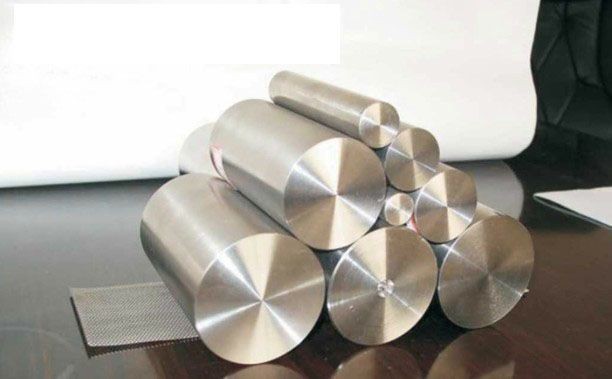
3J21 alloy, also known as Co40CrNiMo alloy, is a commonly used cobalt-based high elastic alloy. The alloy is composed of elements such as cobalt, chromium, nickel and molybdenum, and has a variety of excellent comprehensive properties.
3J21 alloy has excellent elastic properties after deformation heat treatment. It has the characteristics of high elasticity, high fatigue resistance, high corrosion resistance and non-magnetic properties. In addition, it has high strength, hardness, wear resistance and fatigue resistance. It shows high corrosion resistance in a variety of media, and has certain thermal stability and low notch sensitivity.
Due to these excellent properties, 3J21 alloy is widely used in the defense and civil industries. It is particularly suitable for making small-section elastic components and precision devices on aerospace vehicles, such as clock springs, tension wires, shaft tips, special bearings and other elastic sensitive components.
Overall, 3J21 alloy is a high-performance material with broad application prospects and brings many advantages to various industrial fields.
Metallographic structure of 3J21 precision alloy
The metallographic structure of 3J21 precision alloy is austenitic structure.
Austenite is one of the most common structures in steel or alloys. It consists of a face-centered cubic structure and has good plasticity and toughness. The austenite structure has high hardness and strength and can withstand large deformation forces.
In 3J21 alloy, the presence of austenite structure makes it highly elastic and durable, suitable for the application of various elastic parts and precision instruments.
Chemical composition of 3J21
material | 3J21 | |||||||||
chemical composition | p | S | Ni | Mu | Co | C | Mn | Si | Cr | Fe |
≦0.01 | ≦0.01 | 14-16 | 6.5-7.5 | 39-41 | ≦0.03 | 0.3-0.6 | 0.15-0.3 | 19-21 | margin | |
Physical properties of 3J21 precision alloy
material | 3J21 | |
physical properties | density | melting point |
8.4 g/cm3 | 1372-1405℃ | |
Mechanical properties of 3J21 precision alloy
3J21 solid solution state, mechanical properties of the alloy at room temperature:
material | 3J21 | |||
Mechanical Properties | Alloy state | Tensile strength | elongation | Hardness Hv |
3J21 | ≥700 | ≥35 | ≤250 | |
3J21 delivery status, mechanical properties of the alloy at room temperature:
Product Type | Delivery State | Thickness or Diameter | Performance Group | Tensile Strength | Tensile Strength |
belt | cold rolled | 0.20~2.5 | A | 1175~1470 | ≥5 |
belt | cold rolled | 0.20~2.5 | B | 1470~1765 | ≥3 |
bar | cold drawn | 0.20~5.0 | A | 1275~1570 | ≥8 |
bar | cold drawn | 0.20~5.0 | B | 1570~1865 | ≥6 |
Characteristics of 3J21 precision alloy
3J21 precision alloy has the following characteristics:
Non-magnetic: 3J21 alloy has good non-magnetic properties, that is, it will not affect the magnetic field and can be used in magnetically sensitive applications. This makes 3J21 alloy widely used in electronics, communications and other fields.
Corrosion resistance: 3J21 alloy has high resistance to corrosive environments. It can remain stable in corrosive media such as acids and alkalis and is not susceptible to corrosion and oxidation. Therefore, 3J21 alloy is an important choice in applications requiring corrosion resistance, such as in the chemical industry and marine environments.
High elasticity: 3J21 alloy has excellent elastic properties and can return to its original shape under large deformation forces. It is not prone to plastic deformation or remains stable after deformation. This makes 3J21 alloy widely used in high-demand elastic components such as precision instruments, springs, and probes.
To sum up, 3J21 precision alloy has the characteristics of non-magnetic, corrosion resistance and high elasticity, allowing it to find a wide range of applications in various fields.
Heat resistance of 3J21 precision alloy
3J1 alloy has weak magnetism, corrosion resistance and good elasticity, and shows good elastic properties in a temperature range below 200°C. This makes it very suitable for certain industrial applications.
As for the 3J53 alloy, it has a low temperature coefficient of elastic modulus, high elasticity and strength in the temperature range of -60°C to 700°C. This makes it useful where flexibility and strength are required in high-temperature environments.
Overall, these precision alloys exhibit excellent properties within their specific ranges and are widely used in different fields of industry.
3J21 application scope application fields
3J21 alloy has a wide range of applications in the following fields:
Making non-magnetic, corrosion-resistant, highly elastic components: Since 3J21 alloy has an austenitic structure, it is very effective in making non-magnetic components. At the same time, its corrosion resistance and high elasticity make it ideal for making durable components. For example, in the fields of electronic equipment, medical equipment, aerospace and automobile industries, 3J21 alloy can be used to make springs, springs, spring sheets and other components.
Spreading wires, spinning wires, etc. in precision instruments: 3J21 alloy is widely used in the production of stretching wires, spinning wires and other components in precision instruments due to its high elasticity and good resilience. These parts are very important to restore the original shape and accuracy, and 3J21 alloy can meet these requirements, ensuring the accuracy and reliability of the instrument.
Due to the properties of 3J21 alloy, it is widely used in applications requiring high performance, precision and reliability

